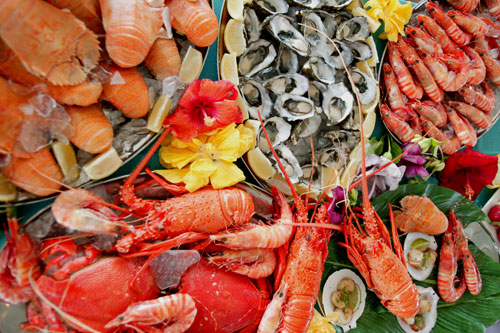
Bored with salmon, but still want to get your Omega 3's?
Prefer a mild-flavored, white fish?
Looking for a more sustainable option in your seafood?
Try Barramundi!
A native of the tropical waters of northern Australia, southeast Asia, and southern China, Barramundi is farmed in the U.S.
If you're worried about farmed fish, don't be. Not all farmed fish is bad. In fact, the Monterey Bay's Seafood Watch program rates U.S. farmed Barramundi a"Best Choice" because of our environmentally friendly farming practices.
Why eat it? Barramundi has 833 mg of heart-healthy omega-3 fatty acids per 5-oz serving and contains less than 150 calories! It's a great source of lean protein, is rich in vitamins and minerals, and is low in saturated fat. Because of U.S. farming practices, it's also free from contamination with PCBs, mercury or other contaminants.

How to buy it? You may find it called Silver Barramundi, Giant Perch, Palmer Perch, and Barra. Locally it can be found at Giant and Safeway.
How to make it? Barramundi has a sweet, mild flavor and light, flaky texture and is super easy to prepare. Below is a recipe and links to more!
Barramundi and Lemon Butter
4 Barramundi fillets
2 tsp. olive or canola oil
2 Tbsp. butter
1 clove garlic, minced
3 Tbsp. fresh or bottled lemon juice
5 leaves minced fresh basil (or 3/4 tsp. dry)
Salt to taste
Gently saute the garlic in butter for about 2 minutes. Stir in lemon juice and basil. Add salt to taste. Remove from heat. Coat fillets with olive or canola oil. Pan fry one side on high heat for 3 minutes. Flip and cook other side 1-2 more minutes or until fish is cooked through. Transfer to serving dish. Spoon sauce over fillets.
Serving Suggestion: Serve on a bed of sauteed spinach or greens, and fresh tomato salsa.
More Recipes:Barramundi with Balsamic Orange Ginger Glaze
Barrumundi with Chili, Tomato, Saffron and Zucchini
Pan Seared Barramundi
Barramundi Fish Tacos Enjoy!
Danielle Omar, MS, RD
The Food Confidence Expert
www.foodconfidence.com








